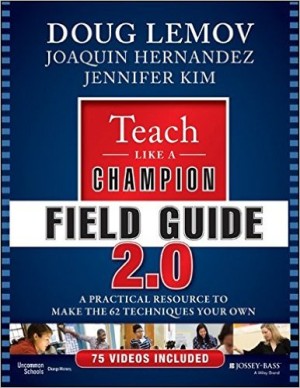06.02.16Where to begin: Prioritizing techniques for new teachers
 My colleagues and I are in Westchester today talking behavior and culture with 160 or so educators. One participant brought up the perennial question that looms large in the minds of those who train new teachers: which technique(s) should we start with? When you’re discussing something as complex as teaching, there are obviously no right or wrong answers to this question. A lot depends on context, time of year, and the teacher(s) themselves. That being said, if I had to take a crack at it, I’d share the following thoughts from the new Teach Like a Champion 2.0 Field Guide—which my coauthors Joaquin Hernandez, Jen Kim, and I are wrapping up for a September release. In this revised and updated edition of the original Field Guide, we share these and other practical ideas and activities that coaches, teachers, and principals can use to bring techniques from Teach Like a Champion 2.0 into the classroom.
My colleagues and I are in Westchester today talking behavior and culture with 160 or so educators. One participant brought up the perennial question that looms large in the minds of those who train new teachers: which technique(s) should we start with? When you’re discussing something as complex as teaching, there are obviously no right or wrong answers to this question. A lot depends on context, time of year, and the teacher(s) themselves. That being said, if I had to take a crack at it, I’d share the following thoughts from the new Teach Like a Champion 2.0 Field Guide—which my coauthors Joaquin Hernandez, Jen Kim, and I are wrapping up for a September release. In this revised and updated edition of the original Field Guide, we share these and other practical ideas and activities that coaches, teachers, and principals can use to bring techniques from Teach Like a Champion 2.0 into the classroom.
We hope this guidance proves useful to you. If you have other favorite starting points, please share those in the comments section below. We look forward to reading them!
Choosing Which Techniques to Start With
You can start wherever you want and as we hope is clear, we hope you’ll choose what you feel is the right spot for you. But some people, we realize, want suggestions. Part 1, Check for Understanding, is a great place to start, especially for an experienced teacher, but if that doesn’t look like the best place for you to begin, there are dozens of other good ones. Here are a few.
Starting with Cold Call . . . and Staying There Awhile
Of all the sixty-two techniques, Cold Call (technique 33) is the one we think might be likely to shift the culture of academic expectations in your classroom the most and quickest. Study it deeply; practice using it slowly and with a smile. Maybe even stay with it when you’re tempted to try something new. Use it to backstop writing and pair discussions, and we think you’ve got a game changer.
Starting from Routines
Some champion teachers argue that great classrooms rest on an everyday culture of strong, apparently (but not really) mundane routines that empower you to teach efficiently and students to excel at academics. Making routine tasks automatic frees more time—often astounding amounts of it—for teaching. You can make almost any routine—from entering the classroom to shifting from one task to another—automatic, efficient, and a source of useful habit. The Chapter 10 techniques, 45 through 50, all focus on building strong routines.
Starting from Planning
A third place to begin is at planning. If you feel that your planning is already strong, why not start with Plan for Error (Technique 7) or Double Plan (Technique 19)? These two focus on reactive planning—how to plan for the unexpected and change course as your lesson demands it. From there you are halfway to mastery of the Check for Understanding unit.
All About Writing
Writing holds a special place in a high-performing classroom. When all thirty of your students engage in thoughtful writing for a sustained period of time, your levels of rigor and participation are both high. Start with Front the Writing (Technique 41) or maybe focus on ending every lesson with a short and focused exercise to help students develop and refine their ideas (…in writing? …through writing?). For that try Art of the Sentence (Technique 38) and Show Call (Technique 39).
Every Teacher Teaches Reading
Control the Game (Technique 23) is a mighty sleeper. It allows you to read an immense amount of text engagingly and positively during class—no matter what subject or grade level—and to connect your students to the pleasure of reading. Once you have that, the sky’s the limit.
A few additional tips from Doug:
Starting Simple
Another common approach is to choose something fairly simple and do-able, that teachers can try and see the difference in their classroom with right away. This builds their faith in the long-term usefulness of training. What to Do or Be Seen Looking might be ideal examples.
Better Together
We also often see leaders at top schools train their teachers in pairs. That is, they have teachers study two techniques at once because there are synergies between the two: Positive Framing and Strong Voice for example. Each makes the other better.

One Response to “Where to begin: Prioritizing techniques for new teachers”